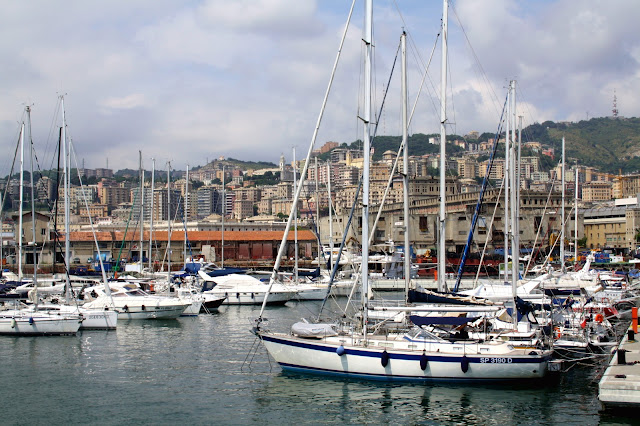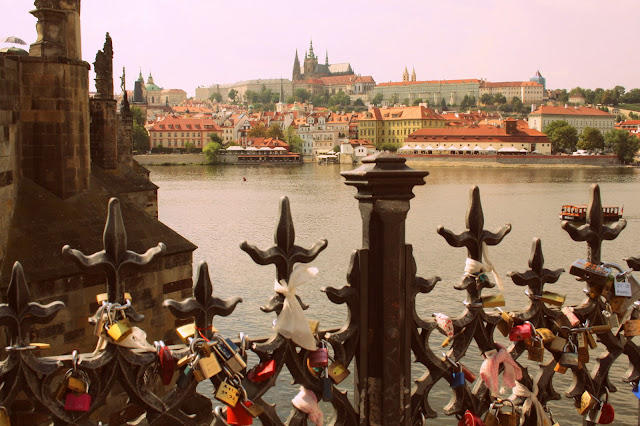Lord Byron w Genui / Lord Byron in Genoa
Współczesna Genua sprawia wrażenie miasta nieco zapomnianego. Do splątanych niczym spaghetti wąskich uliczek rzadko docierają turyści a jeszcze rzadziej promienie słońca. Też jakoś nie miałam ochoty się w nie zagłębiać. Podczas moich dwóch krótkich wizyt próbowałam zlokalizować jakieś centrum - plac, czy ulicę, które pozwoliłby okiełznać wrażenie chaosu i odczucie klaustrofobii. Kiedyś rytm życia miasta dyktował spektakularny port, który dziś nieśmiało przypomina o swojej dawnej świetności.
Today, Genoa seems to have been forgotten. The tangled narrow streets are rarely penetrated by the tourists and even more rarely by the rays of the sun. Somehow I didn't want to immerse myself in it either. During my two short visits, I tried to locate the center - the main square or street that would tame the feelings of chaos and claustrophobia. Once the rhythm of the city's life was dictated by a spectacular port that today timidly reminds of its former glory.
3 października 1822 roku do genueńskiego portu wpłynął jacht "Bolivar" z Lordem Byronem na pokładzie. Po drodze z Pizy, Byron zatrzymał się na kilka dni w miasteczku Lerici, w okolicach którego w lipcu tego roku utonął Percy Shelley. W podróży towarzyszyła mu jego włoska ukochana Teresa Guiccioli. Natomiast jej brat i ojciec, przybyli do Genui kilka dni wcześniej.
Today, Genoa seems to have been forgotten. The tangled narrow streets are rarely penetrated by the tourists and even more rarely by the rays of the sun. Somehow I didn't want to immerse myself in it either. During my two short visits, I tried to locate the center - the main square or street that would tame the feelings of chaos and claustrophobia. Once the rhythm of the city's life was dictated by a spectacular port that today timidly reminds of its former glory.
3 października 1822 roku do genueńskiego portu wpłynął jacht "Bolivar" z Lordem Byronem na pokładzie. Po drodze z Pizy, Byron zatrzymał się na kilka dni w miasteczku Lerici, w okolicach którego w lipcu tego roku utonął Percy Shelley. W podróży towarzyszyła mu jego włoska ukochana Teresa Guiccioli. Natomiast jej brat i ojciec, przybyli do Genui kilka dni wcześniej.
W
znalezieniu zakwaterowania pomogła im Mary Shelley, która mieszkała
tu od trzech miesięcy. Poleciła villę Saluzzo Mongiardino na
wzgórzu Albaro. (Jej obecny adres to via Albaro 3). To willa z XVI
wieku będąca częścią kompleksu rodzinnego Saluzzich.
Lord
Byron arrived in Genoa on October 3, 1822, aboard his yacht
"Bolivar". On the way from Pisa, he stopped for a few days
in the town of Lerici, where Percy Shelley drowned in July this year.
Byron was accompanied by his Italian beloved Teresa Guiccioli. Her
brother and father, however, came to Genoa a few days earlier.
Mary Shelley, who had lived here for three months, helped them find accommodation. She recommended villa Saluzzo Mongiardino on Albaro Hill. (Today's address is via Albaro 3). The villa was built in the 16th century and is a part of the Saluzzi family complex.
W żadnym z listów Byron nie napisał praktycznie nic odnośnie nowego miejsca zamieszkania. Opis ówczesnej willi znajdziemy u hrabiny
Margueritte Blessington, która była częstym gościem Byrona:
"Byron mieszka w willi Casa Saluzzo, która znajduje się w
wiosce Albaro, oddalonej o mniej więcej półtora mili od Genui.
Jest to piękny, stary pałac, z imponującą, rozległą panoramą,
z przestronnymi apartamentami, od frontu wychodzi na dziedziniec, z
tyłu na ogród. Pokój, w którym Lord Byron nas przyjął był duży
i prosto umeblowany. Mój wzrok przyciągnął mały portret jego
córki Ady..."
Byron did not describe his new place of
residence in any of his letters. Description of the villa can be
found at the Countess Margueritte Blessington, who was a frequent
guest of Byron:
"Albaro, the village in which the Casa Saluzzo, where he
[Byron] lives, is situated, is about a mile and a half distant from
Genoa; it is a fine old palazzo, commanding an extensive view, and
with spacious apartments, the front looking into a court-yard and the
back into the garden. The room in which Lord Byron received us was
large, and plainly furnished. A small portrait of his daughter Ada,
(...) struck my eye."
 |
| Wnętrze willi Saluzzo Mongiardino, fot. z 1967 r. |

Można przypuszczać, że Byrona też raczej Genua nie zachwyciła. Miasto praktycznie nie istnieje w jego listach ani utworach. Trudno dziś stwierdzić, co widział i gdzie bywał.
Oczywistością jest, że przynajmniej kilka razy był w porcie a
znając jego fascynację wielkimi postaciami historycznymi, chyba niemożliwe, by nie odwiedził rodzinnego domu Krzysztofa
Kolumba.
There are reasons to assume that Byron was not impressed with Genoa either. The city practically does not exist, neither in his letters nor in his poems. Today it is difficult to say which places he visited. It is obvious that he was at least a few times in the seaport and, knowing his fascination with great historical figures, it is unlikely, that he did not visit the family home of Christopher Columbus.
There are reasons to assume that Byron was not impressed with Genoa either. The city practically does not exist, neither in his letters nor in his poems. Today it is difficult to say which places he visited. It is obvious that he was at least a few times in the seaport and, knowing his fascination with great historical figures, it is unlikely, that he did not visit the family home of Christopher Columbus.
Wysoce prawdopodobne jest, że widział pałac królewski:
Most likely he'd seen the Royal Palace:
W
jednym z listów do swojej przyrodniej siostry Augusty, Byron pisze o
powodzi, która jesienią 1822 roku niespodziewanie nawiedziła
Genuę:
"Mieliśmy
tutaj potop, który porwał połowę wiosek, między tą a wybrzeżem
Genui (...) będąc na wzgórzu, byliśmy prawie powaleni przez
błyskawicę i zbombardowani przez kolumny deszczu a nasze dolne
piętro unosi się nad powierzchnią z wygodnym widokiem na cały
krajobraz pod wodą i ludzi krzyczących przez okna z poddaszy. Dwa
mosty zostały zmiecione - nasi sąsiedzi - szewc, wytwórca peruk i
piekarz pierników dostarczyli cały swój asortyment żywiołowi,
który odmaszerował w butach, kilku perukach i piernikach w każdej
gałęzi."
In
one of his letters to his half-sister Augusta, Byron writes about the
flood that in autumn 1822 unexpectedly hit Genoa:
"We
have had a deluge here which has carried away half the country
between this and coast Genoa – (...) but being on a hill we were
only nearly knocked down by the lightning and battered by columns of
rain and our lower floor afloat with the comfortable view of the
whole landscape under water and people screaming out of their garret
windows. Two bridges swept down – and our next door neighbors – a
Cobbler a Wigmaker – and a Gingerbread baker delivering up their
whole stock to the elements – which marched away with a quantity of
shoes – several perukes – and Gingerbread in all it’s
branches."
 |
| E. F. Batty, Genua, rysunek z 1817 roku |
W trakcie pobytu nad morzem Liguryjskim Byron dość często spotykał
się z Mary Shelley, która w tym okresie zajmowała się
przepisywaniem jego rękopisów, przede wszystkim "Don Juana".
Poznał tu m.in. hrabiego Alfreda d'Orsaya, który naszkicował w
tym czasie kilka portretów poety.
During his stay at the Ligurian Sea coast, Byron was often seeing Mary Shelley, who at that time was transcribing his manuscripts, mainly "Don Juan". Here he met Count Alfred d'Orsay, who sketched several portraits of the poet at the time.
"Jego wygląd jest (...) niezwykle ujmujący; głowa jest
wspaniale ukształtowana, czoło wysokie i szlacheckie; oczy ma szare
i pełne ekspresji, ale jedno jest widocznie większe od drugiego;
jego nos jest duży i dobrze wyprofilowany, jednak trochę za gruby i
wygląda lepiej z profilu niż en face. Najbardziej znakomitą
częścią jego twarzy są z pewnością usta. Górna warga
charakteryzuje się grecką krótkością i opadającymi kącikami;
usta są pełne i mają znakomity kształt. Mówiąc, bardzo pokazuje
zęby, które są białe i równe. Jest wyjątkowo szczupły, tak
bardzo, że jego postać ma niemal chłopięcy wygląd; jego twarz
jest wyjątkowo blada, ale nie wygląda niezdrowo, (...) jego włosy (które szybko stają się siwe) są
mocno ciemnobrązowe i naturalnie się lokują." - zanotowała hrabina Blessington.
Poniżej
Byron podziwiający widok z tarasu Villi Saluzzo:
"His
appearance is (...) highly prepossessing; his head is finely shaped,
and the forehead open, high, and noble; his eyes are grey and full of
expression, but one is visibly larger than the other; the nose is
large and well shaped, but from being a little too thick, it looks
better in profile than in front face, his mouth is the most
remarkable feature in his face, the upper lip of Grecian shortness,
and the corners descending; the lips full, and finely cut. In
speaking, he shows his teeth very much, and they are white and even.
(...) He is extremely thin, indeed so much so that his figure has
almost a boyish air; his face is peculiarly pale, but not the
paleness of ill-health, as its character is that of fairness, (...) his hair (which is getting
rapidly grey) is of a very dark brown, and curls naturally." - as Countess Margueritte Blessington noted.
Below
Byron admiring the view from the terrace of Villa Saluzzo:
W Genui dużo pisał. Tu powstało siedem ostatnich pieśni "Don
Juana", dramat "Niekształtny przekształcony",
powieść poetycka "Wyspa" i satyra polityczna "Wiek
brązu". Z czasem był coraz bardziej pochłonięty
planami wyjazdu do Grecji, by wesprzeć walkę Greków o
niepodległość.
16 lipca 1823 roku Byron na zawsze pożegnał Italię i na pokładzie
statku "Herkules" wypłynął z portu w Genui, w kierunku
Grecji. Była to jego ostatnia podróż.
While
in Genoa, he wrote a lot. Here the last seven songs of "Don
Juan", the drama "The Deformed Transformed", the
poetic novel "The Island" and the political satire "The
Age of Bronze" were written. Over time, he was increasingly
absorbed in plans to go to Greece in order to support the Greek struggle for
independence.

















Komentarze
Prześlij komentarz